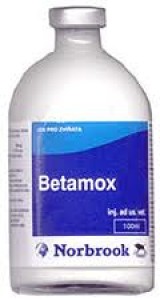
Presentation:
Betamox 150mg/ml Suspension for Injection is an off-white sterile suspension containing:
Amoxicillin (as Amoxicillin Trihydrate 172.1mg/ml) 150mg/ml
Butylated Hydroxyanisole 0.08mg/ml
Butylated Hydroxytoluene as antioxidants 0.08mg/ml
Uses:
Cattle, Sheep, Pigs, Dogs and Cats.
Betamox 150mg/ml Suspension for Injection is a broad spectrum semi-synthetic penicillin, bactericidal in action. In vitro it is effective against a wide range of Gram-positive and Gram-negative pathogenic bacteria which include: Actinobacillus equuli, Actinobacillus lignieresi, Actinomyces bovis, Bacillus anthracis, Bordetella bronchiseptica, Clostridium species, Corynebacterium species, Erysipelothrix rhusiopathiae, Escherichia coli, Fusiformis species, Haemophilus species, Moraxella species, Pasteurella species, Proteus mirabilis, Salmonella species, Staphylococci and Streptococci in cattle, sheep, pigs, dogs and cats
Dosage & Administration:
Cattle, Sheep And Pigs: By intramuscular injection only.
Dogs And Cats: By subcutaneous or intramuscular injection.
The recommended dosage rate is 7mg/kg bodyweight once a day for up to five days. Massage the injection site. A separate injection site should be used for each administration.
Withdrawal Period:
Milk for human consumption must not be taken from a cow during treatment. Milk for human consumption may only be taken after 24 hours from the last treatment. Not for use in sheep producing milk for human consumption. Animals must not be slaughtered for human consumption during treatment.
Cattle may be slaughtered for human consumption only after 18 days from the last treatment. Sheep may be slaughtered for human consumption only after 10 days from the last treatment. Pigs may be slaughtered for human consumption only after 16 days from the last treatment.
Contraindictions, Warnings etc:
This product is not suitable for administration via intravenous or intrathecal routes. Occasional local tissue reaction may result from use of this product. Not effective against beta-lactamase producing organisms. As with other penicillins Amoxicillin should not be used in rabbits, hamsters, gerbils and guinea pigs.
If you notice any serious effects or other effects not mentioned in this leaflet, please inform yourveterinary surgeon.
This product does not contain an antimicrobial preservative. Swab the septrum before removing each dose. Use a dry, sterile needle and syringe.
Care should be taken to avoid accidental self-injection. In the case of accidental self-injection, seek medical advice immediately.
Penicillins and cephalosporins may cause hypersensitivity (allergy) following injection, inhalation, ingestion or skin contact. Hypersensitivity to penicillin may lead to cross reactions to cephalosporins and vice versa. Allergic reactions to these substances may occasionally be serious.
1. Do not handle this product if you know you are sensitised, or if you have been advised not to work with such preparations.
2. Handle this product with great care to avoid exposure taking all recommended precautions.
3. If you develop symptoms following exposure, such as a skin rash, you should seek medical advice and show the doctor this warning. Swelling of the face, lips or eyes or difficulty breathing are more serious symptoms and require urgent medical attention.
4. Wash hands after use.
Pharmaceutical Precautions:
Do not store above 25ºC. Following withdrawal of the first dose, use the product within 28 days. Discard unused material. When the container is broached (opened) for the first time, using the in-use shelf-life which is specified on this package insert, the date on which any product remaining in the carton should be discarded should be worked out. This discard date should be written in the space provided. Dispose of any unused product or containers in accordance with guidance from your local waste regulation authority
Further Information:
High levels of Amoxicillin are found in kidney, urine, liver and bile after absorption due to its wide distribution.
In common with other Penicillins an absence of toxicity is apparent even at high dose levels. Animals with functional rumens should only be treated parenterally.
